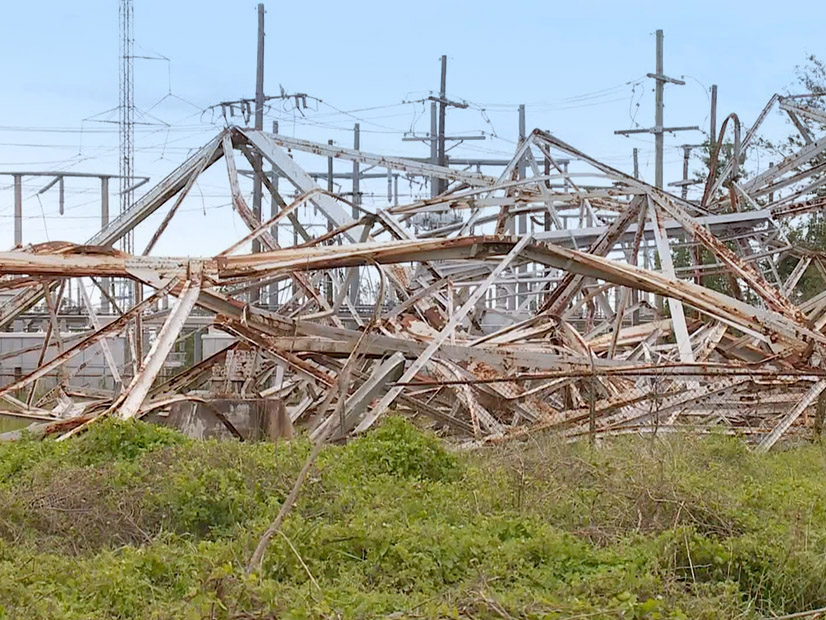The electric grid faces a “range of evolving and complex threats,” from climate change to cybersecurity, Energy Secretary Jennifer Granholm warned Wednesday during the second day of NERC’s GridSecCon 2021 conference.
But those dangers should also be seen as opportunities to build a more robust bulk power system for the future, she said.
The devastation of this year’s Hurricane Ida — which caused nearly a million people in Louisiana and Mississippi to lose power in August — led Granholm’s virtual keynote with NERC CEO Jim Robb. (See Entergy Won’t Estimate Hurricane Ida Restoration Times.)
 Energy Secretary Jennifer Granholm | NERC
Energy Secretary Jennifer Granholm | NERC“This image is so burned in our minds, this image of a transmission tower knocked over after Hurricane Ida across the Mississippi River,” Granholm said. “It sends this really clear message that our power infrastructure has to be hardened for the future of these worsening climate impacts that we have ahead.”
Granholm added that along with the frequency of severe weather events, “the costs of these disasters are escalating.” She noted that over the past three years, the U.S. has spent around $120 billion per year cleaning up from natural disasters, compared to “about $18 billion a year” in the 1980s.
Robb said that in addition to the rising impacts of climate change, the past year has seen an apparent explosion in cyberattacks originating from foreign nations, perpetrated by groups affiliated with nation-states along with more traditional criminal gangs. He mentioned the hack of the SolarWinds Orion platform and Microsoft Exchange, along with the ransomware attack this summer on the Colonial Pipeline that caused the company to shut down its entire network that carries almost half the supply of gasoline, diesel and other fuel products to the U.S. East Coast. (See Experts Call for Cyber Shift in Response to Colonial Hack.)
“We’ve seen a number of risks that we knew were out there come to life, and unfortunately, we got to see them with a front row seat and in Technicolor,” Robb said. “The supply chain attacks — SolarWinds, Microsoft Exchange, [etc.] — really demonstrate the sophistication of our adversaries, and they [show] the bad guys are bad, not dumb.”
New Generation, Transmission Investments Needed
Rather than dwelling on the risks to the grid, Robb and Granholm focused on what NERC and the Department of Energy can do to help strengthen it.
Granholm said preparing for climate change requires the U.S. to “deploy, deploy, deploy clean power sources, so that we don’t continue to aid and abet” the buildup of atmospheric carbon. Along with this, the U.S. must expand and reinforce transmission lines so that electricity can get from these new generating units to where it is needed, while upgrading control systems to allow greater resilience in emergencies.
“That kind of integrated resource planning — not just on a one utility scale or one state scale, but really on a countrywide scale — is absolutely necessary, which is another reason why I’m so happy to be head of a department that has 17 national laboratories … [that] are eager to help out,” Granholm said, noting that the infrastructure bill still winding its way through Congress includes billions for grid improvements and electric vehicle charging. (See Bipartisan Infrastructure Bill Offers Funding for Grid, EVs.)
Robb agreed with Granholm’s support for new transmission, a stance he has repeatedly championed. (See Glick, Robb Call for Tx Build in West.) He also cited NERC’s work with its counterparts in other countries on strategies to common problems: for instance, the organization has studied the response of authorities in Australia and South Africa to wildfires.
Praise for Information Sharing
 NERC CEO Jim Robb | NERC
NERC CEO Jim Robb | NERCTurning to cybersecurity, both Granholm and Robb praised utilities for their willingness to share information about cyber incidents through initiatives like the Cybersecurity Risk Information Sharing Program, operated by NERC’s Electricity Information Sharing and Analysis Center. Granholm acknowledged that publicizing a successful attack might “look like a bad reflection” on a utility, but reminded the industry that “if we don’t know what’s going on, we can’t talk to one another and prevent the next one.”
The secretary also highlighted DOE’s “100-day sprint” to improve cybersecurity at critical electric infrastructure, which the Biden administration announced in April. (See Biden Reinstates Trump Supply Chain Order.) Granholm said the program had gained commitments from 150 utilities, covering almost 90 million customers, to install monitoring sensors and technologies to “enhance visibility into the networks that operate the system.”
Robb reminded viewers that the problems facing the grid require “21st century solutions” and challenged utilities to rethink old assumptions.
“There are no shortage of challenges facing the electric grid as we go forward. I like to think of it as, we’re leaving behind our grandfather’s electric grid, and we’re building our grandchildren’s electric grid. And it’s going to be very different than what we’ve had in the past,” Robb said.




